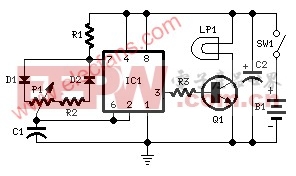亮度控制小灯电路--Brightness Control f
亮度控制小灯电路--Brightness Control for small Lamps
Switching operated 1.5V bulbs
Portable unit, 3V battery supply
Parts:

P1________________470K Linear Potentiometer
R1_________________10K 1/4W Resistor
R2_________________47K 1/4W Resistor (See Notes)
R3__________________1K5 1/4W Resistor
C1_________________22nF 63V Polyester Capacitor
C2________________100F 25V Electrolytic Capacitor
D1,D2___________1N4148 75V 150mA Diodes
IC1_______________7555 or TS555CN CMos Timer IC
Q1_______________BD681 100V 4A NPN Darlington Transistor
LP1_______________1.5V 200mA Bulb (See Notes)
SW1_______________SPST Switch
B1__________________3V (Two 1.5V AA or AAA cells in series, etc.)
Circuit operation: led
This device was designed on request, to control the light intensity of four filament lamps (i.e. a ring illuminator) for close-up pictures with a digital camera, powered by two AA or AAA batteries. Obviously it can be used in other ways, at anyone's will.
IC1 generates a 150Hz squarewave having a variable duty-cycle. When the cursor of P1 is fully rotated towards D1, the output positive pulses appearing at pin 3 of IC1 are very narrow. Lamp LP1, driven by Q1, is off as the voltage across its leads is too low. When the cursor of P1 is rotated towards R2, the output pulses increase in width, reaching their maximum amplitude when the potentiometer is rotated fully clockwise. In this way the lamp reaches its full brightness.
Notes:
LP1 could be one or more 1.5V bulbs wired in parallel. Maximum total output current allowed is about 1A.
R2 limits the output voltage, measured across LP1 leads, to 1.5V. Its actual value is dependent on the total current drawn by the bulb(s) and should be set at full load in order to obtain about 1.5V across the bulb(s) leads when P1 is rotated fully clockwise.



评论